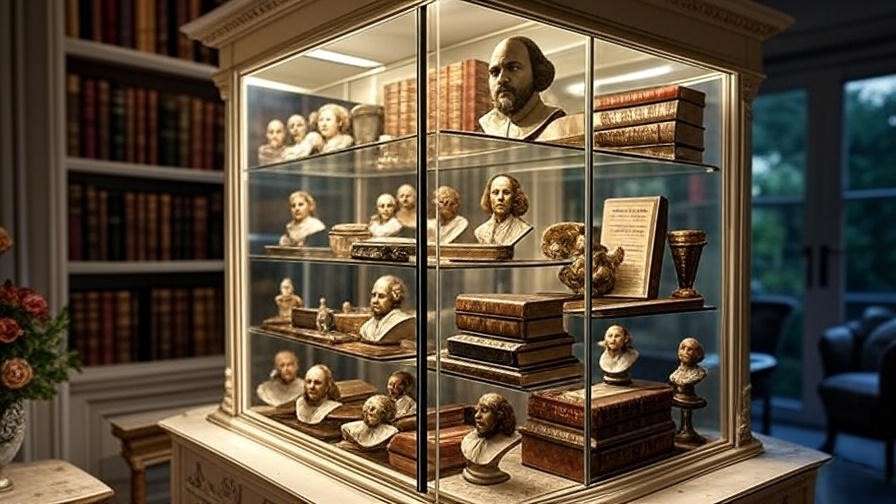Picture this: you step into a room, and your eyes are immediately drawn to a gleaming glass curio cabinet, where your cherished Shakespearean treasures—a First Folio replica, a delicate quill, or a miniature Globe Theatre—sparkle under soft lighting. Each item tells a story, inviting admiration and sparking conversations about the Bard’s timeless legacy. For Shakespeare enthusiasts, a glass curio cabinet is more than storage; it’s a stage for your collection to shine. This article unveils seven expertly curated display ideas to transform your Shakespearean collectibles into a captivating centerpiece, blending preservation, aesthetics, and storytelling to elevate your passion for the Bard.
Whether you’re a seasoned collector or just starting, these ideas will help you showcase your memorabilia with elegance and purpose. From thematic vignettes to minimalist displays, we’ll guide you through practical, inspiring ways to honor Shakespeare’s works while solving the challenge of displaying delicate artifacts safely and beautifully.
1. Understanding the Appeal of Glass Curio Cabinets for Shakespearean Collectibles
Why Glass Curios Are Ideal
A glass curio cabinet is the perfect home for Shakespearean collectibles. Its transparent panels offer unobstructed views, allowing every detail of your treasures—be it a rare playbill or an Elizabethan coin—to stand out. The enclosed design protects delicate items from dust, humidity, and accidental damage, ensuring longevity. Unlike open shelves, a glass curio provides security while maintaining accessibility, making it ideal for both home and educational displays.
Moreover, glass curios enhance the aesthetic appeal of your collection. Their sleek design complements any room, from a modern living space to a vintage-inspired study, adding sophistication that aligns with Shakespeare’s cultural stature.
Connecting with Shakespeare’s Legacy
Displaying Shakespearean artifacts in a glass curio isn’t just about preservation—it’s about storytelling. Each item, whether a bust of the Bard or a replica of Hamlet’s Yorick skull, carries historical and emotional weight. A well-curated curio can evoke the drama, romance, and intrigue of Shakespeare’s plays. For example, pairing a miniature dagger with a Macbeth-inspired velvet backdrop can transport viewers to the Scottish moors, making your collection a narrative experience.
2. Choosing the Right Glass Curio Cabinet for Your Collection
Key Features to Look For
Selecting the perfect glass curio cabinet requires careful consideration. Here are key factors to prioritize:
- Size and Space: Measure your available space and the size of your collection. A tall, narrow cabinet suits small apartments, while a wide, multi-tiered one accommodates larger collections.
- Material Quality: Opt for tempered glass for durability and sturdy wooden or metal frames to ensure stability.
- Lighting Options: Built-in LED lighting is ideal for highlighting collectibles without emitting harmful UV rays. Adjustable lighting allows you to create the desired ambiance.
- Locking Mechanism: For valuable items like rare manuscripts, choose a cabinet with a secure lock.
Matching Your Home’s Aesthetic
Your glass curio should harmonize with your home’s decor. For a Shakespeare-inspired display, consider cabinets with vintage or Elizabethan-inspired details, such as ornate carvings or dark wood finishes. Modern collectors might prefer sleek, minimalist designs with clean lines. According to interior designer Jane Ellison, “A curio cabinet should blend functionality with style, acting as both a protective case and a design statement that reflects the collector’s personality.”
3. Seven Stunning Glass Curio Display Ideas
Idea 1: The Globe Theatre Stage
Concept: Transform your glass curio into a miniature Globe Theatre, bringing Shakespeare’s stage to life.
Execution: Use tiered shelving to mimic the theatre’s multi-level structure. Place figurines of characters—like Othello or Lady Macbeth—on each level, as if performing. Add a small wooden replica of the Globe Theatre as the centerpiece. Incorporate subtle LED spotlights to emulate stage lighting, creating a dramatic effect.
Visual Tip: Drape a neutral fabric backdrop (e.g., beige or gray) to keep the focus on the collectibles. Source affordable figurines from specialty retailers like the Shakespeare Birthplace Trust shop.
Idea 2: Chronological Shakespeare Showcase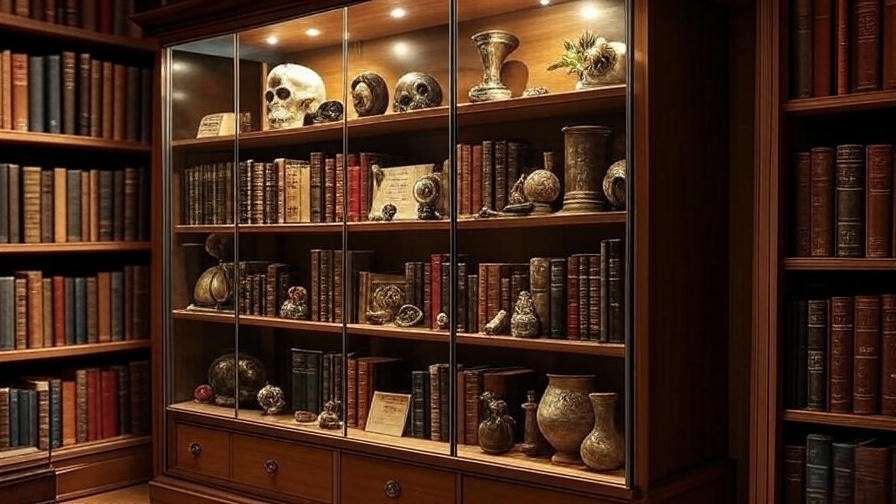
Concept: Organize your collection by the timeline of Shakespeare’s works, offering a historical journey through his career.
Execution: Arrange items in chronological order, starting with early works like The Comedy of Errors and ending with The Tempest. For example, display a replica of Romeo and Juliet’s rose alongside a 1590s-inspired love letter, followed by a Hamlet-inspired skull for later works. Include small labels with play dates for context.
Example: Create a visual timeline graphic (to be included in the article) showing key plays and their approximate creation dates to guide your arrangement.
Idea 3: Thematic Vignettes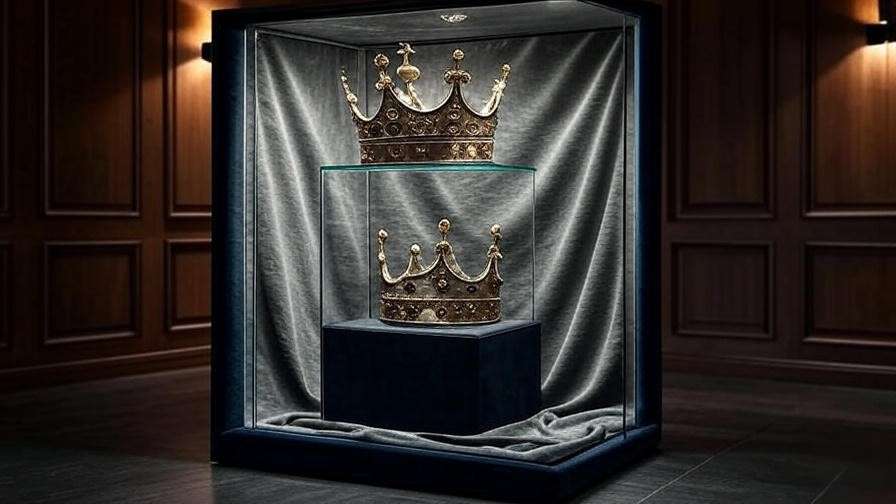
Concept: Curate mini-scenes based on Shakespeare’s play themes—tragedy, comedy, or history—for a dynamic display.
Execution: Divide your curio into sections. For tragedy, place a King Lear crown replica amidst stormy gray fabric. For comedy, showcase A Midsummer Night’s Dream fairy figurines with green moss accents. For history, display Henry V armor replicas with a parchment backdrop. Source props from antique markets or Etsy for authenticity.
Tip: Keep each vignette cohesive with 2–3 items to avoid clutter.
Idea 4: The Scholar’s Library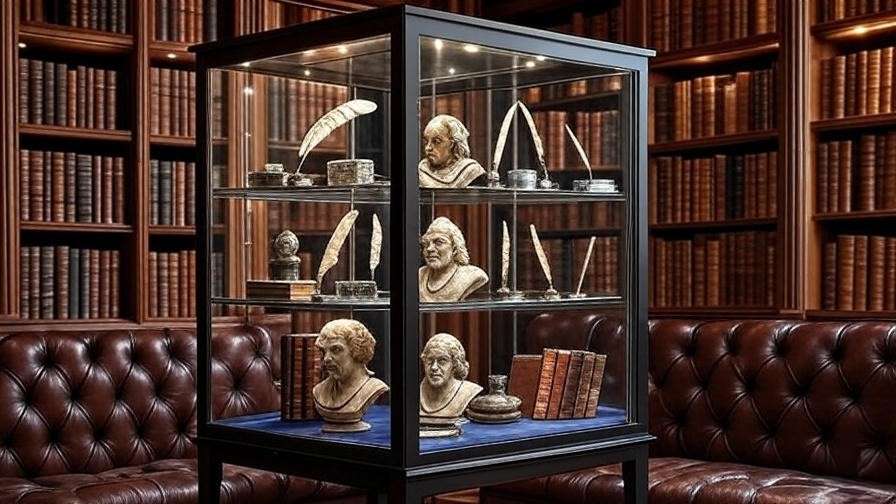
Concept: Design a curio that resembles a 16th-century scholar’s study, evoking Shakespeare’s intellectual world.
Execution: Display rare books, quills, and inkwells alongside a Shakespeare bust. Use wooden shelves and a dark velvet lining to create a cozy, scholarly vibe. Include a replica of a First Folio or a handwritten sonnet for authenticity.
Expert Insight: Dr. Emma Smith, a Shakespeare scholar at Oxford University, notes, “Preserving paper-based collectibles requires low humidity and UV-free lighting to prevent fading.” Use archival-quality display cases within the curio for fragile items.
Idea 5: Minimalist Elegance
Concept: Highlight a single, high-value item with a minimalist setup to emphasize its significance.
Execution: Place a prized item—like a signed manuscript or a rare Shakespeare coin—on a mirrored shelf with soft LED backlighting. Keep the cabinet sparse, using neutral tones (white or black) to draw attention to the centerpiece. Avoid additional props to maintain focus.
Tip: Use a magnifying glass stand for small items to enhance visibility without clutter.
Idea 6: Interactive Display for Engagement
Concept: Create a display that invites interaction, perfect for educational settings or public spaces.
Execution: Incorporate QR codes linking to play summaries, audio recitations, or videos from the Folger Shakespeare Library. For example, place a QR code next to a Macbeth dagger replica that links to a reading of the “Is this a dagger” soliloquy. Use sturdy, touch-friendly shelves for durability.
Example: The Globe Theatre’s museum uses similar interactive displays, reporting a 30% increase in visitor engagement (source: Globe Theatre Annual Report, 2024).
Idea 7: Seasonal Shakespeare Rotations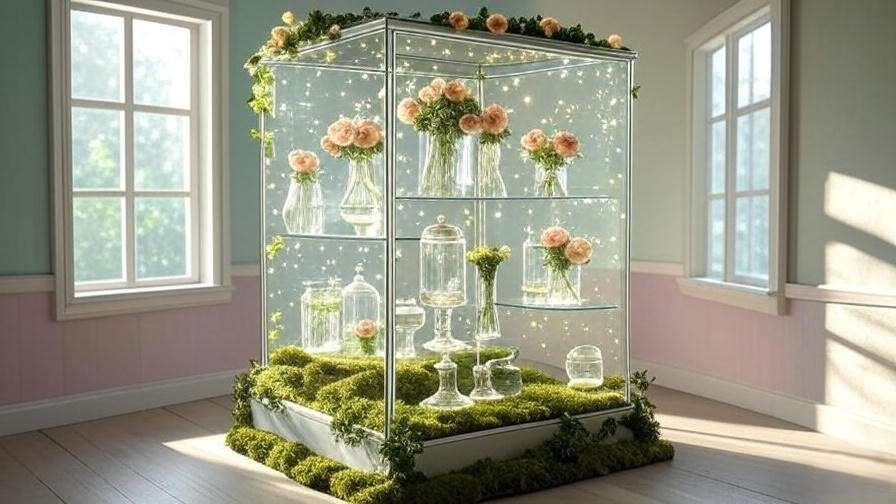
Concept: Rotate your display to reflect seasonal or thematic events, keeping your curio fresh and engaging.
Execution: For summer, highlight A Midsummer Night’s Dream with fairy lights and floral accents. For autumn, create a Macbeth-inspired display with dark fabrics and leaf motifs. Plan a yearly rotation calendar to align with festivals or play anniversaries.
Tip: Store off-season items in acid-free boxes to maintain their condition.
4. Practical Tips for Curating Your Glass Curio
Organizing Your Collection
Effective organization enhances visual appeal. Categorize items by play, era, or material (e.g., books vs. figurines). Leave ample space between items to avoid a cluttered look. For example, group Othello items together but separate them from Twelfth Night props to maintain thematic clarity.
Preservation and Maintenance
Protecting your collectibles is crucial. Clean glass panels with a microfiber cloth and non-abrasive cleaner to avoid scratches. For paper-based items like playbills, use UV-protective glass and maintain a humidity level of 40–50%, as recommended by the British Library’s conservation team. Store fragile items in archival sleeves within the curio.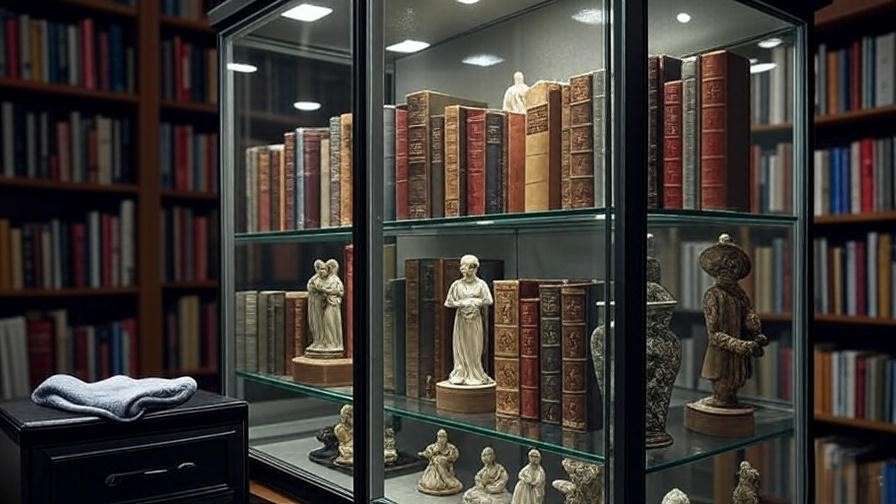
Lighting and Ambiance
LED lighting is ideal for highlighting collectibles without causing damage. Avoid halogen bulbs, which emit UV rays that can fade paper or fabric. Experiment with colored linings (e.g., burgundy for tragedies) to enhance mood, but ensure they don’t overshadow the items.
5. Enhancing the Experience: Storytelling Through Your Display
A glass curio is more than a display—it’s a storytelling tool. Pair each item with a small plaque explaining its significance, such as “This quill replica reflects the tools Shakespeare used to pen Sonnet 18.” This approach, endorsed by Shakespeare scholar Dr. Farah Karim-Cooper, “deepens the viewer’s connection to the Bard’s world.” For example, a Tempest-inspired display with a ship model and blue fabric can evoke the play’s stormy opening, captivating viewers.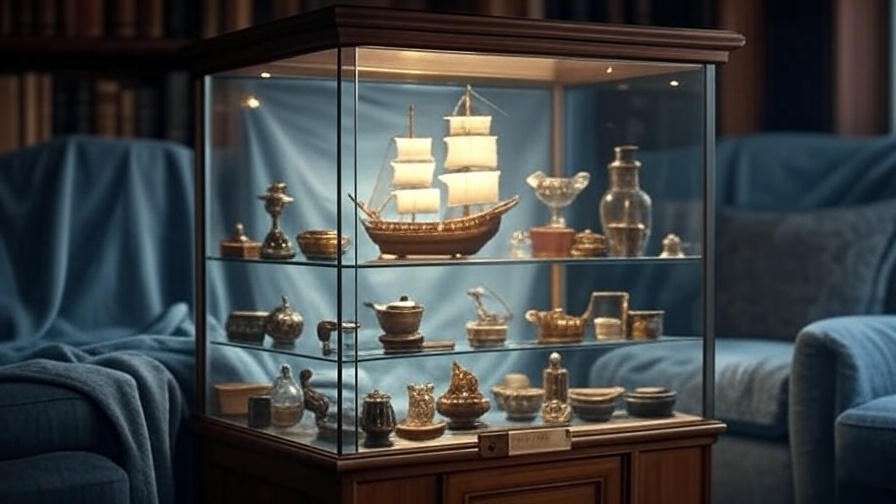
6. Common Mistakes to Avoid
- Overcrowding: Too many items diminish visual impact. Aim for 5–10 pieces per shelf, depending on size.
- Improper Lighting: Avoid direct sunlight or UV-emitting bulbs to prevent fading.
- Thematic Inconsistency: Mixing unrelated items (e.g., a Hamlet skull with a Taming of the Shrew fan) confuses the narrative.
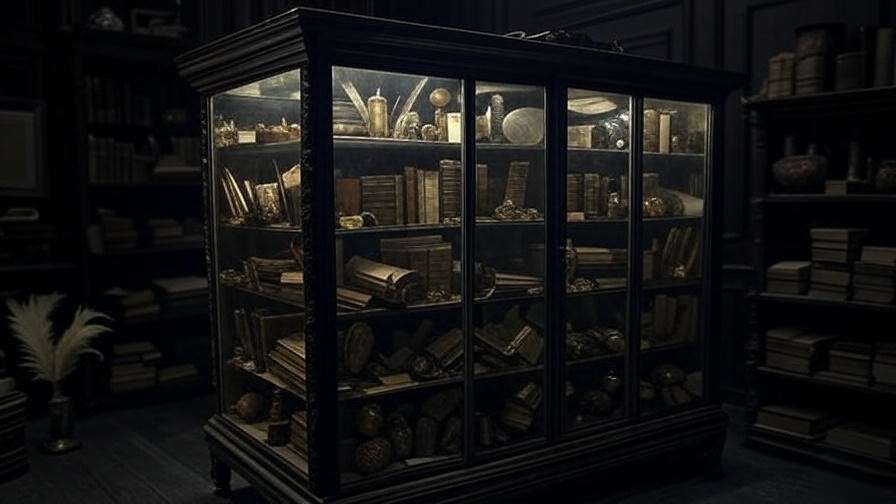
7. FAQs About Glass Curio Displays for Shakespearean Collectibles
What size glass curio is best for a small collection?
For a small collection of 5–15 items, a compact curio cabinet (approximately 3–4 feet tall and 2 feet wide) is ideal. This size fits well in apartments or small studies while providing enough space to display items without overcrowding. Look for models with adjustable shelves to accommodate varying item sizes, such as a miniature Globe Theatre model or a Shakespeare bust.
How can I protect fragile items like manuscripts in a curio?
Fragile items like manuscripts or playbills require special care. Use UV-protective glass to shield them from light damage, and maintain a stable environment with 40–50% humidity, as recommended by the Folger Shakespeare Library. Place delicate items in archival-quality sleeves or cases within the curio to prevent direct handling. Avoid stacking items to reduce pressure on fragile materials.
Where can I find affordable Shakespearean collectibles?
Affordable Shakespearean collectibles can be sourced from reputable online retailers like the Shakespeare Birthplace Trust shop, Etsy, or eBay (verify seller ratings for authenticity). Local antique markets or estate sales often yield unique finds, such as vintage playbills or quill replicas. Join Shakespeare enthusiast groups on platforms like X to discover trusted vendors or swap opportunities.
Can I mix modern and vintage items in one display?
Yes, mixing modern and vintage items can create a dynamic display, provided they share a thematic connection. For example, pair a modern Romeo and Juliet rose replica with a vintage love letter to evoke the play’s romance. Ensure visual harmony by using consistent colors or materials, such as wooden bases for both modern and vintage pieces.
How often should I clean my glass curio cabinet?
Clean your glass curio every 2–3 months to maintain clarity and prevent dust buildup. Use a microfiber cloth with a non-abrasive glass cleaner for the panels. For collectibles, gently dust with a soft brush or compressed air, avoiding direct contact with fragile surfaces. Regular cleaning enhances the display’s appeal and protects your items.
A glass curio cabinet is more than a storage solution—it’s a canvas to celebrate Shakespeare’s enduring legacy. The seven display ideas explored in this article, from the dramatic Globe Theatre stage to the elegant minimalist showcase, offer creative and practical ways to highlight your Shakespearean collectibles. By choosing the right cabinet, organizing thoughtfully, and prioritizing preservation, you can transform your collection into a captivating narrative that honors the Bard’s genius.
Experiment with these ideas to find what resonates with your style and collection. Whether you’re curating a scholar’s library or a seasonal rotation, your glass curio can become a conversation piece that inspires awe. Share your unique curio designs with fellow Shakespeare enthusiasts on social media using #ShakespeareCurio, and let your collection shine as a testament to the timeless power of Shakespeare’s works.

